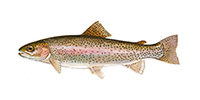Thank you for visiting the Seafood Selector. EDF is planning a new approach to providing information to consumers about good seafood choices. Please come back soon for updates.
Trout

Rainbow trout
Recommended servings per month
| Contaminant | Men | Women | Kids 6-12 | Kids 0-5 | |
|---|---|---|---|---|---|
| Rainbow trout (farmed) | Mercury | 4+ | 4+ | 4+ | 4 |
| Rainbow (Steelhead) trout (US, farmed) | Mercury | 4+ | 4+ | 4+ | 4+ |
Eco details:
These salmon relatives are largely farmed. Conventional operations use large amounts of fishmeal and fish oil (and hence more wild fish) in their feed.
- All rainbow trout on the U.S. market is farmed-raised in the U.S., where farming operations are held to strict environmental standards. Improvements to feed have enabled less wild fish to be used. Rainbow trout are farmed in raceways, which mimic a free-flowing river and use large amounts of freshwater.
- Arctic char, a less well-known relative, comes primarily from eco-friendly farms that conserve water and prevent water pollution.
- Steelhead are raised in open-water netpens, which have problems similar to those for farmed Atlantic salmon, such as polluting local waters.




